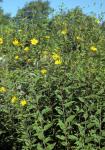BLUE SPRINGS, Mo. — If you’re looking for low-maintenance perennials that can take the heat in the summer and the cold in the winter, native plants should be at the top of the list. Yet gardeners often don’t consider natives for the vegetable garden, says a University of Missouri Extension horticulturist.
“In fact, few perennial vegetable crops are commonly grown in the Midwest,” said Marlin Bates. “Outside of asparagus and rhubarb, most gardeners can’t think of perennial vegetables.”
However, there is a native perennial vegetable sitting on the edge of obscurity in popular culinary culture: the Jerusalem artichoke.
Also known as sunchoke, the Jerusalem artichoke (Helianthus tuberosus) is a sunflower. It is not as attractive as Helianthus species marketed as sunflowers, but the plant does produce 2- to 3-inch-wide flowers in late summer, increasing its ornamental value, Bates says.
As the Latin name suggests, Jerusalem artichokes develop tubers, which are the edible portion of this plant. The sunchoke is unrelated to the globe artichoke, whose edible portion is the developing flower bud.
“This tuberous growth contributes to the notorious spreading habit that may explain the limited cultivation of this plant,” Bates said. “Many people who are familiar with this plant despise its ability to aggressively take over large spaces. Many reports indicate that once you’ve planted them, you’ll have them forever.”
Keep this in mind if you consider planting sunchokes, and place them in an area that is appropriate for “naturalizing.”
Like Irish potatoes (also tubers), Jerusalem artichokes are planted as sections of cut-up tubers. Whole sunchokes should be cut into 2-ounce pieces with at least two “eyes” just prior to planting. “Don’t let the tubers dry out before planting as you would for Irish potatoes,” Bates said.
Seed tubers are available by mail order in fall or winter. Planting can be done in the fall, but soil temperatures need to be in the low 40s to prevent shoot growth before winter. Sunchokes may also be planted in spring as soon as the soil can be worked, but seed tubers may be harder to find that time of year. Space plants at least one foot apart in rows at least two feet apart.
Plants can reach heights of 10 to 12 feet throughout the season. Tuber development does not occur until very late in the season when plants sense cooler temperatures and begin to deposit energy into the underground stems.
Harvest should be done after killing frosts wilt the top growth. Sunchokes harvested later into the cold season will be sweeter than those harvested earlier. Since the plant is a perennial and the tuber is not at threat of winter desiccation, delay harvest until just prior to use. Replanting is typically not necessary because it is difficult to completely harvest a stand of tubers. Those that remain in the soil will produce next year’s crop.
While the Jerusalem artichoke can grow well in most of North America and is adaptable to a broad range of soil types, including heavy clay, tuber formation will be best in loose, fertile soils that are well-drained.
Jerusalem artichokes can substitute for Irish potatoes in many recipes because they are quite similar. Bates notes that an important difference of interest to diabetics is how the plants store energy: While potatoes store energy as starch, sunchokes store energy in the form of inulin, a fiber that has a much smaller effect on blood sugar when consumed.
Read more http://extension.missouri.edu/news/DisplayStory.aspx?N=1533





